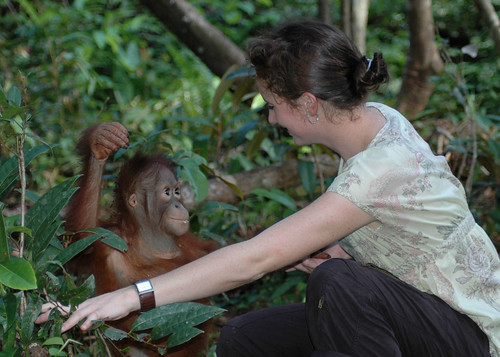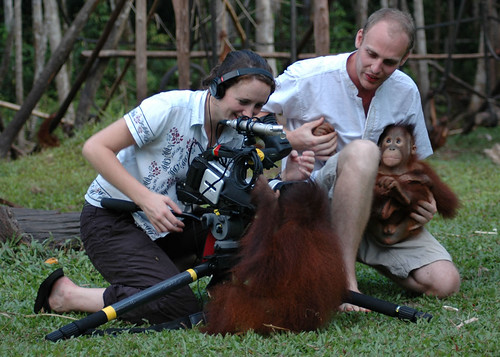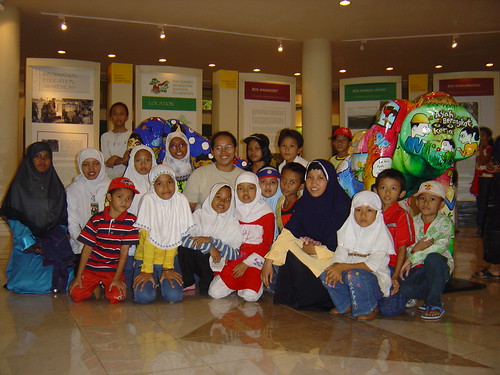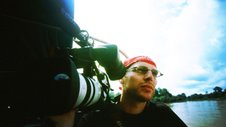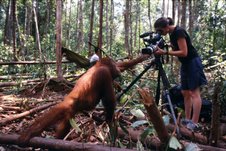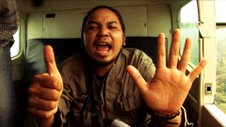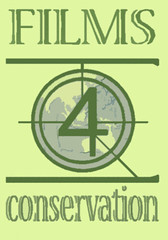Thursday, July 28, 2005
Thursday, July 21, 2005
Danau Sembuluh and Tanjung Puting
We are then visiting the Tanjung Puting National Park. This was for many years the only area granted national park status in Central Kalimantan, and was made famous through the work of Birute Galdikas, one of the original three "big name" female primatologists who worked under the tutelage of Louis Leakey, together with Dian Fossey and Jane Goodhall. Sadly, the borders of Tanjung Puting, which houses not only orangutan but also large populations of proboscis monkeys, slow lorises, sun bears, leaf monkeys, tarsiers, hornbills and more are now being lost to the incursion of the palm oil plantations. Through a legal loophole, three different palm oil conglomerates have recently been granted concessions for plantations which intrude a mile into the Eastern border of the national park land itself. Tanjung Puting is world famous due to the diversity and rarity of the species which inhabit it. We plan to film some of the logging sites which are already destroying large areas of this precious habitat.
Posted by
Films4Conservation
at
6:34 am
0
comments
![]()
Labels: shooting diary
Friday, July 08, 2005
Notes from the field
Friday 8th July 2005
Orangutan Film Protection Project
On location: Nyaru Menteng, Central Kalimantan
Just as the team unload the crate from the pickup Evie arrives. She managed to get an hour’s sleep – it will have to do – she needs to film the setting of the leg. We both know I might pass out. Indra is trying to get an angle with the blowpipe. It’s harder than one might think – it’s dark in the crate and there are limbs in the way. Jhon tries to illuminate the scene with a torch. The shot’s in but not all the sedative injected. Eko lifts the crate door and an arm grabs for something, so they quickly and carefully lower the door to pin the arm down. The rest of the sedative is administered. Eko looks to me and says he’ll call this one Nick, is it ok? Sure, I’d love to have an orangutan named after me. There’s no more movement from the crate. Jhon shakes the crate gently to see if there is any reaction. There is not.
With the crate door up they pull it backwards to reveal the orangutan. On closer inspection Eko informs me that “Nick” is a female of 11-12 years...
There is a large medical kit on the floor: stethoscope, suture kit, syringes, antiseptic, bandages and viles of medicine. I film cut away shots and zoom to get a closeup of the needle as Eko clears the air bubbles. A drop glistens in the sun as it makes its way down the needle. Indri is holding the patient’s head. She is treated with gentle tenderness. There is a deep gash on one of her fingers. I can see the white of the bone amid the semi-congealed blood. I ask Eko whay happened.
Eko: She’s from the sawit (palm oil plantation). The workers attacked her with...I don’t know in English.
Nick: Dalam Bahasa Indonesia
Eko: Dengan parang
Nick: a knife...
Evie and I knew these sorts of encounters between the orangutans and plantation workers were common, but we didn’t expect to witness the results as soon as we arrived. I’m filming as Eko disinfects the wound, but when he brings out the needle and thread Evie instinctively take the camera from me. I try not to look too much, Evie say it is gross. We shoot close ups of the patient’s face throughout the check-up procedure. She is not unconscious, just immobilised. She watches Evie and I. We are standing a little way back to give the team room to work. She looks to be in absolute shock. 12 years in the jungle, learning her territory, fruiting times for different trees, medicinal properties of different plants. Everything has changed now. Palm oil has replaced her home and she has suffered an encounter with scared men with knives. Now she will be put in a cage...I’m not sure when or where she will be released. Suitable territory is disappearing at an alarming rate. Her lip is trembling. I don’t know if this is due to the sedative or the shock. It leaves me deeply disturbed.
Neither Evie nor I have seen footage like this before. Maybe television won’t buy it, but it needs to be seen. People need to know what is happening here.
Lone says that last week a plantation called up to say that they had caught an orangutan – BOS try to stop them from doing this – without a tranquiliser dart the only way this can be done is by beating the orangutan. The team arrived to find the orangutan tied down so tightly the hands were almost severed – it died shortly after. If they’d called the centre and not attempted to catch it this orangutan would still be alive.
We film the leg setting in the afternoon. Although it’s a more traumatic operation the young male doesn’t seem as affected by it as the ordeal of the older female. The broken leg was an accident. The cut was a result of an attack. For a young orangutan there are constantly new experiences and encounters – every day is a learning experience. He will, no doubt, be scared – but perhaps this is not so disturbing as the situation of an older more experienced orangutan finding itself in traumatic circumstances.
The power cuts out again tonight. We eat in the dark cavernous house. The candlelight illuminates numerous rats, and a couple of bats circle around the eaves. The reassuring sound of geckos tells us that at least something is eating the mosquitoes that are eating us. In my sleep I dream of six-foot tall rats.
Posted by
Films4Conservation
at
11:08 am
0
comments
![]()
Labels: shooting diary
Thursday, July 07, 2005
Notes from the Field
Thursday 7th July 2005
The Orangutan Film Protection Project
On Location: Nyaru Menteng, Central Kalimantan
We’re told that the young male has suffered a broken leg. The team splinted his leg in the field, before moving him; but Lone feels his foot and it is cold. She is worried that the bandages might be too tight. Lone talks with Eko and they decide to resplint the leg before morning. The team lift the crate off the pickup and put it in fornt of the car’s headlights. The power cut out a few hours earlier so the car is the best availabel source of light.
I’m squatting on the ground between the headlights. There’s enough light to film here and I’m not getting in the way. The slight exertion starts me sweating, again. Eko administers more sedative to immobilise the young male. Lone comments that he’s more placid than most orangutans of this age when first caught, even so, he needs to be still for Eko to work on his leg. The break is in a tricky position – his right femur just above the knee joint. It would have been easier to immobilise the bone if the break was in the middle. Tonight’s splinting is only a temporary measure. Tomorrow Eko will set the bone straight and put it in a cast.
I’m getting tired – we only flew in this morning and were up late last night packing and sending vital emails from Jakarta. Evie takes the camera and continues to shoot. Evie and I are both exhausted, but the natural adrenaline release brought on by witnessing this event keeps us going. Once the leg has been resplinted Eko gives the orangutan another injection to rouse it from it’s sedation. The team moves quickly to get the orangutan back into its crate, the drug is fast acting and he begins to stir immediatley. Lone covers him with blankets and puts some hoter water bottles in the crate – he’s still cold. The team will work on his leg again tomorrow, when it’s light. The larger male’s wounds are not so serious – he will stay in his crate until morning. The cages at the centre are full, there are too many orangutans coming in. Lone will have to find room in the morning.
We finally head back to Aula. From the track there are a network of wooden walkways traversing the peat swamp. Our house sits on stilts above the swamp. We’re locked out. Luckily Lone is with us. She is small so we manage to help her through a small, high window. We’re grateful we don’t have to spend the night on the stoop. Inside the barn-like pondok there are high vaulted ceilings. The cooler evening air hasn’t yet cleared the day’s heat. The third room we try has a fan that works. I set to stringing our mosquito nets in a way that we can walk around the room without clothes-lining ourselves. Evie fills up our wooden shelves with dried and tinned food that we brought from town. We’ve misplaced our water bottle. Evie brushes her teeth with apple juice, I just go to bed. The fan struggles to send it’s breeze my way, my mosquito net absorbs what little reaches me. I fall asleep at once. Evie is kept awake by the rats in our room throughout the night.
Posted by
Films4Conservation
at
11:10 am
0
comments
![]()
Labels: shooting diary
Wednesday, July 06, 2005
Thanks to BOSF and the Pusat Primata Schmutzer
Photograph BOSF Communications and the Team(L-R): Nick, Willy, Yudhi, Lili, Sally and Evie.
We would like to extend our gratitude to the BOS Foundation Communications team based at the Pusat Primata Schmutzer in Jakarta - for their support in the last few weeks. With the help of this team we have now acquired all the neccessary permits for filming in Kalimantan, and are due to leave this Thursday. We are also very grateful for the invaluable advice and enthusiasm of Pak Made, Colin & Hannah.
Posted by
Films4Conservation
at
11:06 am
0
comments
![]()
Labels: shooting diary
Monday, July 04, 2005
Pusat Primata Schmutzer, Ragunan Zoo, Jakarta
Posted by
Films4Conservation
at
12:32 pm
0
comments
![]()
Labels: shooting diary
Saturday, July 02, 2005
Going Undercover
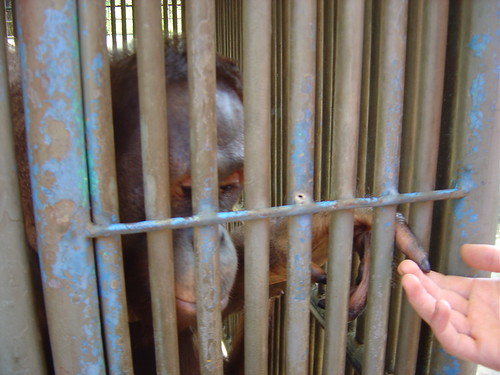
Posted by
Films4Conservation
at
5:40 pm
0
comments
![]()
Labels: shooting diary
How to make a Donation
Cockroach Productions,
The Old Tannery,
Staplegrove,
Taunton,
Somerset,
TA2 6SP
For supporters outside the United Kingdom, we ask that you email us at:
cockroachproductions@gmail.com
and then we can advise you how to transfer funds. Please note that posting messages directly onto the blog does not give us your reply email address, so if you wish to contact us please email the address above.
The Team has just returned to the UK (September 2005), and we are now getting stuck in to the editing process. We still need help. We have stunning and powerful images that tell the story of palm oil and the social and environmental disaster that is surrounding it - we need your help to get this message out. Please help.
Thank you for your generous support, and best wishes from the OFPP team.
Posted by
Films4Conservation
at
4:44 am
0
comments
![]()
Friday, July 01, 2005
On Location - Pusat Primata Schmutzer, Java, Indonesia
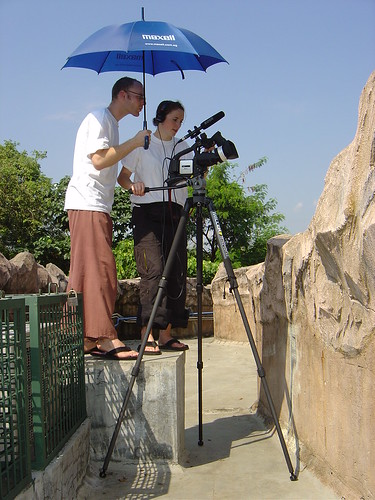
Today we started shooting the first Indonesian footage for the film: a good start to the new month. We are now staying at the Pusat Primata Schmutzer (Schmutzer Primate Centre) where we are building up footage of the education programmes that teach Indonesian children about the concepts of conservation and the variety of primate species in Indonesia, and the threat that many of these species are facing with logging and plantation concessions and illegal activities. Through this we are hoping to illustrate the efforts being made locally to protect the future of the forests and their inhabitants.
Posted by
Films4Conservation
at
10:17 am
0
comments
![]()
Labels: shooting diary
